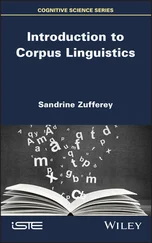Finally, if we take noun roots, we can create adjectives such as boy-ish and child-ish using the suffix -ish, verbs such as motor-ise and demon-ise with the suffix -ise and complex nouns such as boy-hood, child-hood and nation-hood by means of
the suffix -hood. These options are summarised in table 15 (exercise 1).
To date, we have seen various examples of derivations enabling us to form
new lexemes in English. Derivation is not the only function of morphology,
however. In the previous section, we considered examples such as Tom reads comics, pointing out that the verb reads consists of the base form read and a suffix
-s. However, this suffix doesn’t create a new lexeme; rather it signals agreement with a third person singular subject of the sentence (as well as the fact that the verb is present rather than past tense). Realising agreement is an important function Table 15 Examples of derivational morphology in English
Derived form
Basic form
Noun
Verb
Adjective
Noun
boy-hood
motor-ise
child-ish
Verb
print-er
re-write
read-able
Adjective
sad-ness
short-en
un-happy
Building words
145
of inflectional morphology, and it is much more widespread in some languages than in English.
The -s ending which signals agreement in English is often thought of as a
morpheme. However, such a morpheme does not have a meaning in the way that
re- or -er/-or have meanings. Rather, it is an inflection which expresses an inflectional category (of agreement) and the purpose of this category is to signal a syntactic relationship, that of the verb to its subject. It is in this sense that we have to interpret rather broadly the notion of a morpheme as a minimal sign
having a single meaning. Indeed, it is often thought appropriate to resort to a more neutral terminology in such cases. Instead of regarding the English agreement suffix -s as a morpheme, we can refer to it as an inflectional formative (or simply an ‘inflection’), and instead of saying that an inflection means, say, ‘third person singular’, we say that it is the exponent of the property ‘third person singular’. As we will see in section 11, there is much more than just terminology at stake here.
A further important concept can now be introduced if we return to (108). We have already noted that (108a, b) illustrate two word forms of the lexeme CAT.
However, both of these word forms ‘contain’ the word form cat – (108a) just is cat, whereas (108b) is cat-s. Thus, we need to observe that the word form cat is found in two distinct functions in (108). In (108a), it is simply the singular form of the noun, but in (108b), it is the form of the noun to which the plural suffix is added. The form obtained when we remove inflections is called the stem. In
regular nouns in English the stem is always the same as the singular word form.
However, in a plural form such as knives the stem is pronounced with a voiced final fricative [naɪv], while the singular ends in an unvoiced fricative [naɪf]. In other words, the plural form of the lexeme KNIFE has a special stem form. Note that the notion of stem is distinct from that of root. The root is the smallest morphological form associated with a lexeme, while a stem is that form to
which inflections are added. Thus, the root of the word form printers is print, but the stem (of the plural form) is printer-, which itself consists of a root and a derivational suffix print-er-.
The important distinction between lexemes and word forms enables us to
explain a widely observed phenomenon in morphology: inflectional affixes tend to appear outside derivational affixes. Thus, in English we have painter ‘one who paints’, a form of a derived noun lexeme (PAINTER), composed of a form of the verb lexeme PAINT and the suffix -er. The plural form of this new lexeme is painter-s and not *paint-s-er. This makes sense if we regard plural formation as
something which happens to the lexeme. The morphological rule of plural for-
mation is to add -s to the end of the stem of the lexeme: cat-s, painter-s, and this rule doesn’t need to worry about whether the lexeme itself is derived or not.
Clearly, we can’t form the plural of a derived lexeme such as painter until we have created that new lexeme, so we do not see forms such as *paint-s-er.
A further complication concerning the notion of ‘word’ can be appreciated if we return to the inflectional categories of English verbs discussed in section 9. If we
146
words
take a regular verb lexeme such as CROSS, it has the word forms cross, crosses, crossing and crossed. Setting the base form cross and third person singular present form crosses aside, let’s focus attention on crossed. As we have observed, one function of this form, illustrated in (110), is to express past tense: (110)
The dog crossed the road safely
Additionally, recall that a form such as crossed helps to form the perfect aspect construction with the auxiliary verb have as in (111) (see p. 136): (111)
I have crossed this road before
We have referred to the word form crossed in this construction as the perfect participle, and the same form is found with the passive voice combined with the auxiliary verb be:
(112)
This river is crossed by three bridges
In (112), crossed is referred to as the passive participle. But now note that the terminology we have introduced to date for replacing the unclear concept ‘word’
does not enable us to come to terms with these distinctions. Focusing entirely on the lexical verb, there is only one lexeme in (110)–(112), namely CROSS.
Furthermore, there is only one word form of this lexeme in these examples,
namely crossed. It is necessary, then, to introduce a third sense of ‘word’ which is distinct from both lexeme and word form. We need to convey the fact that the single word form crossed corresponds to two distinct inflected forms, the past tense form of CROSS and the perfect/passive participle form of CROSS. We will call a description such as ‘the past tense form of CROSS’ a grammatical word or morphosyntactic word. This means that crossed corresponds to two grammatical words, though it is a single word form of a single lexeme. At this point, it is useful to recall that in the previous section, we insisted that perfect/passive participle forms should be referred to as the -n forms of verbs even when they were suffixed with -ed. It should now be clear that the distinction between the -d and -n forms of verbs which we introduced there is a distinction between two grammatical words.
In many cases, this distinction corresponds to a distinction between two word forms (ate ~ eaten, sang ~ sung, gave ~ given); in the case of regular verbs, however, only one word form corresponds to these two grammatical words (crossed ~
crossed, walked ~ walked, jumped ~ jumped, etc.) (exercise 2).
The -ing suffix is also rather complex. Suffixed to a verb form which is
combined with the auxiliary be, it forms the progressive participle in a progressive aspect construction, as in (113):
(113)
Harriet is sending a text message
It is also used to create from a verb a form which has some of the characteristics of nouns, as (114) shows:
(114)
Sending text messages is easy
Building words
147
In this example, the phrase sending text messages behaves rather like an ordinary noun such as linguistics in linguistics is easy. However, in a phrase such as the person sending text messages, the word seems to behave more like an adjective, in that it forms a phrase, sending text messages, which serves to describe person, rather like the adjective responsible in the person responsible for this message.
Читать дальше
![Andrew Radford Linguistics An Introduction [Second Edition] обложка книги](/books/397851/andrew-radford-linguistics-an-introduction-second-cover.webp)











